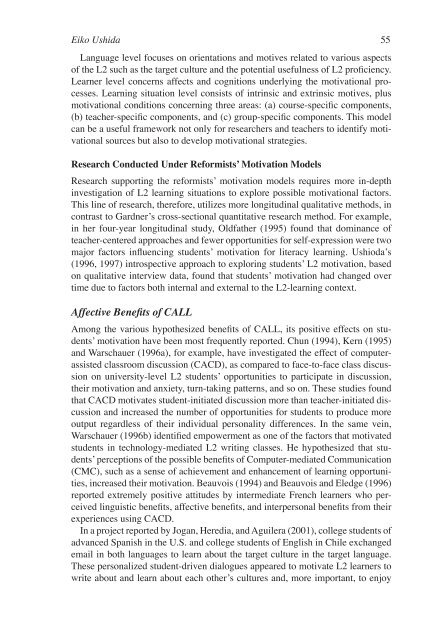The Role of Students' Attitudes and Motivation in Second ... - CALICO
The Role of Students' Attitudes and Motivation in Second ... - CALICO
The Role of Students' Attitudes and Motivation in Second ... - CALICO
Create successful ePaper yourself
Turn your PDF publications into a flip-book with our unique Google optimized e-Paper software.
Eiko Ushida 55<br />
Language level focuses on orientations <strong>and</strong> motives related to various aspects<br />
<strong>of</strong> the L2 such as the target culture <strong>and</strong> the potential usefulness <strong>of</strong> L2 pr<strong>of</strong>iciency.<br />
Learner level concerns affects <strong>and</strong> cognitions underly<strong>in</strong>g the motivational processes.<br />
Learn<strong>in</strong>g situation level consists <strong>of</strong> <strong>in</strong>tr<strong>in</strong>sic <strong>and</strong> extr<strong>in</strong>sic motives, plus<br />
motivational conditions concern<strong>in</strong>g three areas: (a) course-specific components,<br />
(b) teacher-specific components, <strong>and</strong> (c) group-specific components. This model<br />
can be a useful framework not only for researchers <strong>and</strong> teachers to identify motivational<br />
sources but also to develop motivational strategies.<br />
Research Conducted Under Reformists’ <strong>Motivation</strong> Models<br />
Research support<strong>in</strong>g the reformists’ motivation models requires more <strong>in</strong>-depth<br />
<strong>in</strong>vestigation <strong>of</strong> L2 learn<strong>in</strong>g situations to explore possible motivational factors.<br />
This l<strong>in</strong>e <strong>of</strong> research, therefore, utilizes more longitud<strong>in</strong>al qualitative methods, <strong>in</strong><br />
contrast to Gardner’s cross-sectional quantitative research method. For example,<br />
<strong>in</strong> her four-year longitud<strong>in</strong>al study, Oldfather (1995) found that dom<strong>in</strong>ance <strong>of</strong><br />
teacher-centered approaches <strong>and</strong> fewer opportunities for self-expression were two<br />
major factors <strong>in</strong>fluenc<strong>in</strong>g students’ motivation for literacy learn<strong>in</strong>g. Ushioda’s<br />
(1996, 1997) <strong>in</strong>trospective approach to explor<strong>in</strong>g students’ L2 motivation, based<br />
on qualitative <strong>in</strong>terview data, found that students’ motivation had changed over<br />
time due to factors both <strong>in</strong>ternal <strong>and</strong> external to the L2-learn<strong>in</strong>g context.<br />
Affective Benefits <strong>of</strong> CALL<br />
Among the various hypothesized benefits <strong>of</strong> CALL, its positive effects on students’<br />
motivation have been most frequently reported. Chun (1994), Kern (1995)<br />
<strong>and</strong> Warschauer (1996a), for example, have <strong>in</strong>vestigated the effect <strong>of</strong> computerassisted<br />
classroom discussion (CACD), as compared to face-to-face class discussion<br />
on university-level L2 students’ opportunities to participate <strong>in</strong> discussion,<br />
their motivation <strong>and</strong> anxiety, turn-tak<strong>in</strong>g patterns, <strong>and</strong> so on. <strong>The</strong>se studies found<br />
that CACD motivates student-<strong>in</strong>itiated discussion more than teacher-<strong>in</strong>itiated discussion<br />
<strong>and</strong> <strong>in</strong>creased the number <strong>of</strong> opportunities for students to produce more<br />
output regardless <strong>of</strong> their <strong>in</strong>dividual personality differences. In the same ve<strong>in</strong>,<br />
Warschauer (1996b) identified empowerment as one <strong>of</strong> the factors that motivated<br />
students <strong>in</strong> technology-mediated L2 writ<strong>in</strong>g classes. He hypothesized that students’<br />
perceptions <strong>of</strong> the possible benefits <strong>of</strong> Computer-mediated Communication<br />
(CMC), such as a sense <strong>of</strong> achievement <strong>and</strong> enhancement <strong>of</strong> learn<strong>in</strong>g opportunities,<br />
<strong>in</strong>creased their motivation. Beauvois (1994) <strong>and</strong> Beauvois <strong>and</strong> Eledge (1996)<br />
reported extremely positive attitudes by <strong>in</strong>termediate French learners who perceived<br />
l<strong>in</strong>guistic benefits, affective benefits, <strong>and</strong> <strong>in</strong>terpersonal benefits from their<br />
experiences us<strong>in</strong>g CACD.<br />
In a project reported by Jogan, Heredia, <strong>and</strong> Aguilera (2001), college students <strong>of</strong><br />
advanced Spanish <strong>in</strong> the U.S. <strong>and</strong> college students <strong>of</strong> English <strong>in</strong> Chile exchanged<br />
email <strong>in</strong> both languages to learn about the target culture <strong>in</strong> the target language.<br />
<strong>The</strong>se personalized student-driven dialogues appeared to motivate L2 learners to<br />
write about <strong>and</strong> learn about each other’s cultures <strong>and</strong>, more important, to enjoy
















